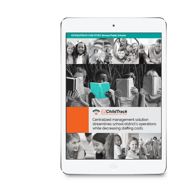
Every childcare center should have an emergency plan to address and mitigate risks. Since childcare is regulated by the state, you should verify the requirements for your facility.
The most effective childcare emergency plans will:
- Provide clear instructions on the roles and responsibilities for all emergencies and crises
- Include procedures to handle a variety of hazards and natural disasters
- Meet the specific needs and criteria for your facility
- Involve coordination with local emergency responders
- Consider safety regulations and codes such as the International Fire Code and NFPA Life Safety Code
- Address multi-jurisdictional issues in mass care, sheltering, and evacuation
Let’s take a look at six areas you must consider when preparing your emergency plan, but first, some information on the different types of emergencies for which you may need to prepare.
Types of Emergencies and Crises to Address
An emergency is not the same as a crisis, but you must prepare for both.
Emergency - an urgent need that calls for immediate action such as a school shooting, tornado, gas leak, or fire.
Crisis - An unfolding situation that has reached a critical phase with the distinct possibility of a highly undesirable outcome such as a hostage situation or terrorism.
Some emergencies and crises can occur anywhere while certain regions of the United States have potential hazards peculiar to them. Most emergency plans for childcare facilities will include responses for the following:
- Fights on the grounds
- Potentially volatile public demonstrations
- Disasters
- Deaths
- Violent incidents
- Medical issues
- Traffic and utility issues
Depending on where your facility is located you may require specialized responses for:
- Earthquakes
- Flooding
- Tornadoes
- Hazards caused by train derailment or nearby animals
- Chemical hazards
Contact your local FEMA offices or county emergency management agency to determine whether your facility is near any particular hazardous activity.
Six Tips for Preparing for Childcare Emergencies:
1. Prepare an Emergency Kit
You need a portable emergency kit that can be carried to the site of the problem. You must appoint someone to be responsible for both keeping it filled and up-to-date as well as for retrieving it in case of an emergency.
Do not allow anyone to pilfer supplies from it; it should be completely stocked at all times. If you have multiple facilities, make sure someone at each facility takes responsibility for stocking the kit and putting in its proper place at each location.
Consult the Childcare Emergency Preparedness Toolbox for the items to include in your emergency kit.
2. Prevention
Prevention programs provide a safe environment within and around your facility. Typically it includes policies against bullying including the consequences. Other unacceptable behaviors are included. Emphasis is placed on respect, fairness, and tolerance.
Part of your prevention policy should include training for the staff so they can learn to identify destructive behavior and the best response.
- Encourage everyone to report bullying and threats to safety.
- Reinforce acceptable behavior while applying consequences for violating the rules.
- Teach the bullying includes name-calling, rumors, gestures, and online threats, not just physical aggression.
For older students, provide hotlines and other anonymous methods of making reports and letting everyone know that what they report is kept confidential.
3. Assign a Chain of Command or Form a Crisis Response Team
The best-laid plans will not work if the responsibility for each step is left to chance. Everyone should have a role and responsibility; everyone should know who is in their chain of command. Remember that some staff will be taking care of children and cannot take on much more responsibility.
Many schools have a crisis response team consisting of people who are there every day and who have been trained to act in an emergency. Each childcare location should have a copy of the policy and a guide to help them through various emergencies.
4. Hold Drills
The best way to learn is to do. Schools have always conducted fire drills, extreme weather drills, and “stranger” drills. By performing the act of gaining safety, the children and adults learn where to go and what to do so that if they must seek shelter or safety, they will be familiar with the routine.
Perform drills for sheltering in place, evacuating, and lockdowns. Each situation requires a different response. Make sure the signals for each are clearly identifiable and that any changes are practiced as soon as possible.
Teach everyone that the drill is serious and that it’s OK to feel afraid as long as they do what they are supposed to. Then all will be safe.
5. Develop Communications Pathways
Nobody will be more scared in an emergency than the kids, except for their parents. When you enroll a student in your childcare center, part of your onboarding procedure should include how communications will be handled in case of emergency.
Make certain you have all applicable phone numbers to reach each parent as quickly as possible and stress to the parents to keep their records up to date. With childcare management software you can provide online parent portal access for each parent to review and update all of their records from home.
Childcare software can also help you locate the correct contact information quickly anytime you need it.
6. Training with Childcare Management Software
Like drills, training should be required for each new hire and student. Periodically you should repeat the training, which goes into more depth than a simple drill.
The drill is to create muscle memory. Training provides the reasons behind the drills and ensures everyone is playing from the same book on safety, hazardous situations, and unsafe situations.
Nothing is more important than safety. The state requires you to have an emergency plan in place. Parents expect you to keep their children safe. You and your staff will feel more confident if you have learned what to do and practiced it.
Emergencies and crises occur rapidly and demand a nearly automatic response from everyone involved. Childcare management software can provide a safety net by allowing easy access to information. Parents can update phone numbers, immunization records, and other data that may be needed if someone is hurt or ill.
Regularly review your safety policy to ensure it is up to date. Make an individual responsible for keeping the emergency kit stocked and safe. Set up roles and responsibilities, so everyone knows what to do.
It’s better to know what to do and never have to do it than the other way around.




